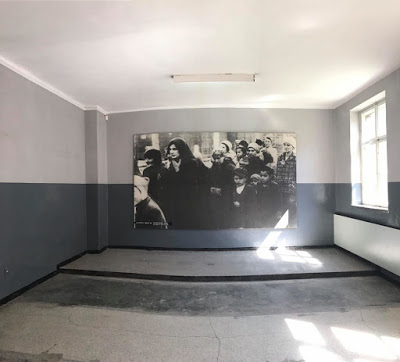
“Nothing here is black and white,” our tour guide explained. “The world is very complicated.” He continued gesturing towards the rows of black and white faces lining the walls. This discussion of color or lack thereof continued throughout our tours of the Auschwitz-Birkenau concentration camps. In fact, everything we saw and did during the week of the AJC’s Human Rights Summer Program seemed to involve the debate of experiencing history in color or black and white. Our tour guide had not been wrong; except in the case that quite literally, everything is black and white for me.
I was born with Achromatopsia, a disorder that among its various vision impairments, is often defined by a lack of color vision. I have only ever seen the world in black and white and in shades of gray due to this. This lack of color is also how we must view most of history before the development and use of colorized media. For anyone who can see color, this impairment in viewing historical photographs and video is understandably unnatural. I have learned that many people see the black and white as a barrier that makes it hard to truly feel the impact of what is being seen. So, is the authenticity of viewing and experiencing history defined by seeing it the way it was originally presented to us or in the way that is most comfortable to our own standards? While this question would probably produce more debate than answers, I can at least offer my own literal view.
Seeing a gas chamber that aided the murder of 1.1 million people in black and white did not make it any less horrifying. Looking at a lake containing human ashes in black and white did not make the scene any less painful. Seeing the rows of faces of men and women who perished at Auschwitz I and Birkenau in black and white did not make me any less sad than anyone else. For me, there is no barrier that needs breaking when touring a site like this in person. In black and white or in color, we must first be grateful that we get to see and preserve it at all for the memory of those who suffered there.
Natasha Caudill is currently going into her sophomore year of college at Knox College in Illinois where she is pursuing a major in American studies and a minor in Marketing. She was adopted from Ukraine when she was younger but has grown up in Alabama and Tennessee. Her hobbies include harboring an ever-growing collection and shrine of history books, anything theatre related, film, and watching historical documentaries.
The Auschwitz Jewish Center is operated by the Museum in Oświęcim, Poland. For additional blog entries by and about the Auschwitz Jewish Center, please visit: https://mjhnyc.org/tag/ajc. All Summer 2017 newsletter articles are found here.